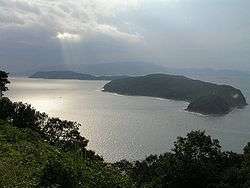Tomogashima


Tomogashima (友ヶ島) is a cluster of four islands in the Inland Sea, off Wakayama, Wakayama, Japan. The four islands are Jinoshima (地ノ島), Kamishima (神島), Okinoshima (沖ノ島), and Torajima (虎島). The islands form part of the Setonaikai National Park.[1][2]
History
The islands were used by Buddhist monks for Shugendō. The folklore of the region holds that Ennogyoja, the founder of shugendo, underwent training on the steep cliffs of Tomogashima in the seventh to eighth centuries. This gave rise to the nickname of "The island of shugendo (mountain asceticism)" for Tomogashima.
Later, during the Meiji period, a brick fort and lighthouse were built.[1][3] Also during this time gun batteries and other defences, along with various support facilities, were constructed to counter foreign warships. Tomogashima was a critical component of the Shusei Kokubō (守勢国防 - i.e. "Static Defence") policy of the 1870s and 1880s, which emphasised coastal defences. Access to the cluster by the public was strictly prohibited by the Imperial Japanese Army up to the end of World War II.[4]
Depictions in art
Tomogashima is the subject of a scroll of 1661 in the Shōgo-in in Kyoto by Kanō Tan'yū as well as an anonymous work of 1798 in the British Museum.[3][5]
See also
- Tomogashima Lighthouse
- Setonaikai National Park
- Imperial Japanese Navy
- List of Army Fortresses in Japan
References
- 1 2 "Photo Museum - Tomogashima". Wakayama Prefecture. Retrieved 1 February 2012.
- ↑ "Setonaikai National Park - Map 1" (PDF). Ministry of the Environment. Retrieved 1 February 2012.
- 1 2 "Views of Tomogashima, a handscroll painting". British Museum. Retrieved 1 February 2012.
- ↑ Whispers of priests and warriors / Military past pervades Tomogashima island The Japan News by the Yomiuri Shimbun, July 14th, 2013.
- ↑ Hirayama Ikuo & Kobayashi Tadashi, edd. (1992). 秘藏日本美術大觀 (Hizō Nihon bijutsu taikan), Vol. 2. Kodansha.
External links
Coordinates: 34°16′55.9″N 135°0′39.5″E / 34.282194°N 135.010972°E